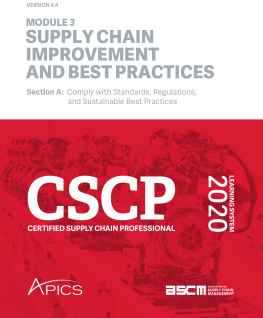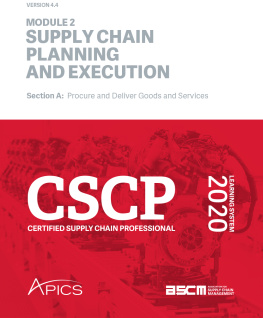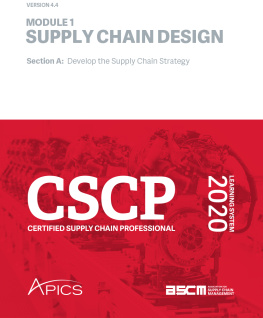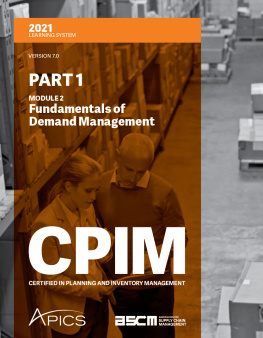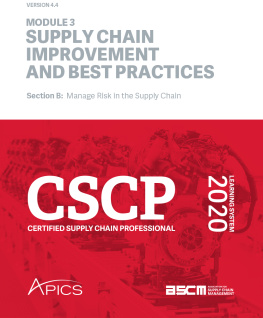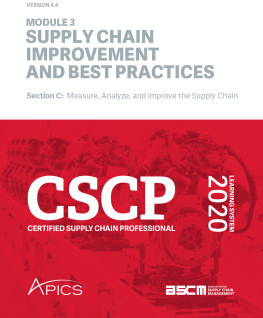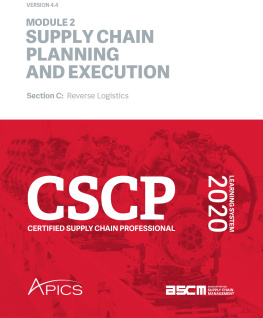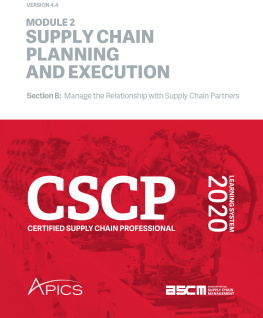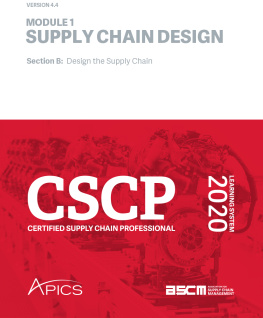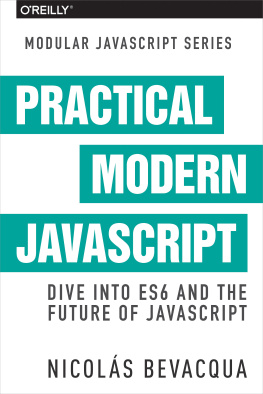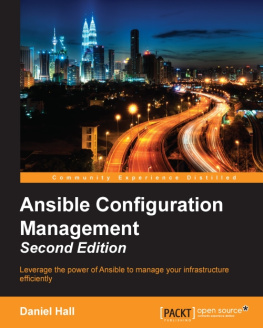APICS - CSCP 2020 Module 3 Section A
Here you can read online APICS - CSCP 2020 Module 3 Section A full text of the book (entire story) in english for free. Download pdf and epub, get meaning, cover and reviews about this ebook. genre: Home and family. Description of the work, (preface) as well as reviews are available. Best literature library LitArk.com created for fans of good reading and offers a wide selection of genres:
Romance novel
Science fiction
Adventure
Detective
Science
History
Home and family
Prose
Art
Politics
Computer
Non-fiction
Religion
Business
Children
Humor
Choose a favorite category and find really read worthwhile books. Enjoy immersion in the world of imagination, feel the emotions of the characters or learn something new for yourself, make an fascinating discovery.
- Book:CSCP 2020 Module 3 Section A
- Author:
- Genre:
- Rating:3 / 5
- Favourites:Add to favourites
- Your mark:
- 60
- 1
- 2
- 3
- 4
- 5
CSCP 2020 Module 3 Section A: summary, description and annotation
We offer to read an annotation, description, summary or preface (depends on what the author of the book "CSCP 2020 Module 3 Section A" wrote himself). If you haven't found the necessary information about the book — write in the comments, we will try to find it.
CSCP 2020 Module 3 Section A — read online for free the complete book (whole text) full work
Below is the text of the book, divided by pages. System saving the place of the last page read, allows you to conveniently read the book "CSCP 2020 Module 3 Section A" online for free, without having to search again every time where you left off. Put a bookmark, and you can go to the page where you finished reading at any time.
Font size:
Interval:
Bookmark:
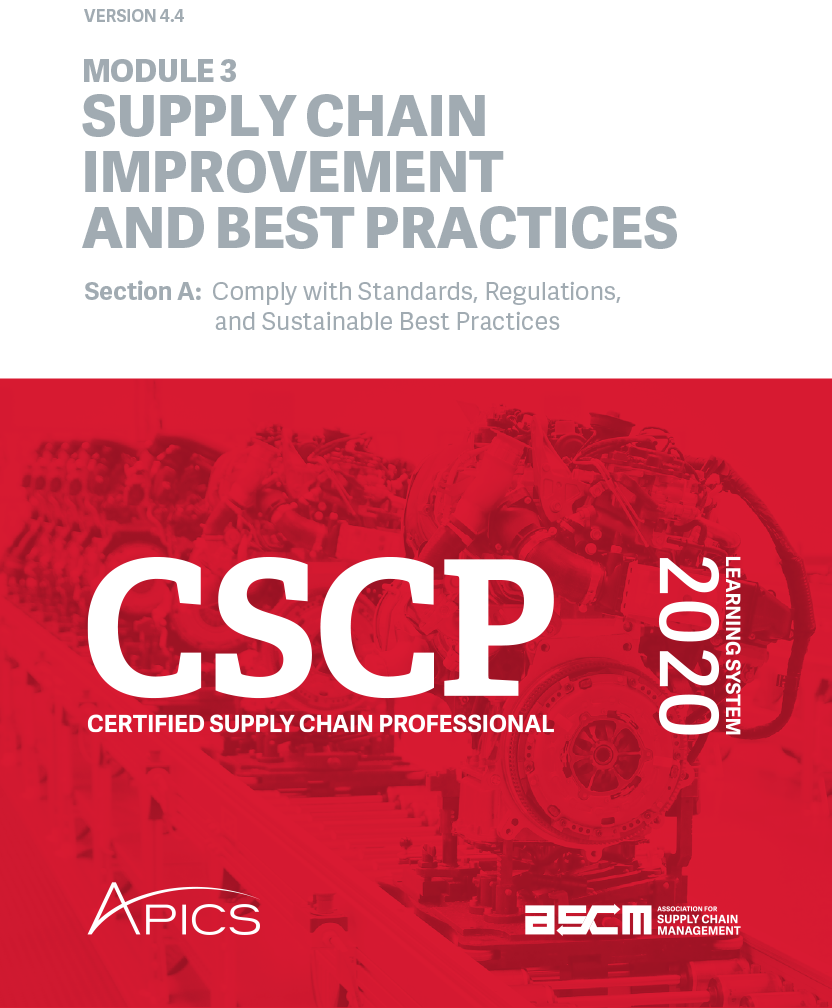
This section includes discussion of compliance such as customs, intellectual property, software and technology licensing, global accounting, and labor law. The section also addresses the triple bottom line of economic, environmental, and social sustainability and some methods of reporting or aligning organizational policies and procedures to international expectations in these areas.
The key processes that supply chain managers need to be able to perform related to complying with standards, regulations, and sustainable best practices are
Identifying applicable standards, regulations, and sustainable best practices
Performing gap analysis for compliance
Developing and implementing an action plan.
Each of these processes is introduced next. Note that these are general overviews. The information required to plan and execute these processes is presented later in this sections topics.
The process of identifying applicable standards, regulations, and sustainable best practices (compliance items) involves the following steps:
Reviewing organizational process assets (existing procedures, tools, and documentation) for currently applicable compliance items
Developing, hiring, or contracting with applicable persons or organizations to gain expertise in compliance items
Scanning for global, national, regional, community, and industry-specific compliance items (including laws and taxes) in each area of operation, differentiating between applicable versus nonapplicable as well as applicable compliance items that:
Promote operations such as reduced tax zones
Constrain operations such as end-of-life reverse supply chain requirements
Differentiating between mandatory versus voluntary items
Updating records and procedures to add any new mandatory items
For voluntary items, doing a cost-benefit analysis to determine which compliance items are advantageous to pursue
Updating records and procedures to add new voluntary items that are advantageous to pursue
The process of performing a gap analysis for compliance involves the following steps:
For all mandatory compliance items, determining level of existing compliance
Comparing actual compliance against baselines for minimum compliance
Creating a list of mandatory item gaps
For all voluntary compliance items, determining desired level of compliance
Comparing actual voluntary compliance against desired compliance targets
Creating a list of voluntary item gaps
The process of developing and implementing an action plan involves the following steps:
For mandatory compliance gaps, developing and executing project plans to address the issue(s)
Keeping relevant regulatory authorities appraised with all necessary information on remediation plans and statuses
For voluntary compliance gaps, developing a feasibility study to better understand the scope of the changes, their costs, and the timeline
Implementing approved voluntary compliance programs as projects
Updating relevant policies, procedures, processes, and metrics to enforce compliance steps and ensure that the changes become part of operations
Using change management to change the culture and get the workforce behind the new methods.
This chapter is designed to
Describe how to efficiently deal with customs and package goods when importing or exporting goods
Protect intellectual property while working in multiple countries
Comply with software and technology licensing requirements
Understand the basics of global and country-specific accounting systems and which countries use various systems
Understand the impact that differences in international, country, and local labor laws can have on global supply chains.
Global supply chains need to operate efficiently as goods and services move between countries. This includes making wise import and export decisions such as how to facilitate clearing customs between countries. Supply chains that operate internationally also need to understand that there are different perspectives on intellectual property and take steps to protect these assets. Similarly, they need to be compliant with software and technology licensing (and ensure others are compliant with their licenses).
Clearing customs can be routine, or it can be a serious obstacle to delivering cargo on time.
The purposes of each countrys customs regulations are twofold: to provide revenue and to protect domestic industries. Imported goods, therefore, can be seen as a source of national revenue, as a threat, orambivalentlyas both. This built-in conflict of interest doesnt make the job of importing (or exporting) into a country any easier or more predictable.
Aside from assessing import duties, customs also inspects shipments with the following intentions:
To confirm that the goods actually have the value stated on the shipments documentation, since that value partly determines the amount of the import duties
To determine that the items have all the correct markings, including safety labels, instructions, identification of country of origin, and any special marks required
To weed out any forbidden items, such as illegal drugs and goods judged not to meet certain national standards
To enforce quotas
To ensure that the invoice is correct and that the shipment contains the number of items claimed in the documentation
To discourage dumping of products by imposing a high percentage duty (Dumping is when a company exports a product at a price lower than what the product normally sells for in the country where the company operates. There is a link for additional anti-dumping information online in the Resource Center.)
To expedite a successful clearance of customs, both importer and exporter should either do thorough research on the importing countrys import regulations or hire competent intermediaries to guide them. Customs regulations are a moving target, subject to change whenever new threats arise (or are perceived to arise); hiring a specialist who keeps an eye on that target improves a companys chance of hitting it on the first try. Intermediaries such as freight forwarders, EMCs, and export packagers can help with the preparations. Because clearing customs successfully is so important, most companieseven the largest onesrely upon experienced customs house brokers.
Here are a few general considerations to keep in mind when formulating a strategy for getting your cargo through customs unimpeded:
Use a customs house broker with proven expertise. Only a licensed broker can transact business with customs, which means that importers must use a broker to submit documents to customs to release their goods. Importers are responsible for providing the necessary documents and information to the broker according to customs time lines and regulations and arranging for the payment of duties found due. (A broker can pay on the importers behalf.) Licensed brokers must have a power of attorney from the importer to act as its agent unless the broker is in-house or works for the same company.
Font size:
Interval:
Bookmark:
Similar books «CSCP 2020 Module 3 Section A»
Look at similar books to CSCP 2020 Module 3 Section A. We have selected literature similar in name and meaning in the hope of providing readers with more options to find new, interesting, not yet read works.
Discussion, reviews of the book CSCP 2020 Module 3 Section A and just readers' own opinions. Leave your comments, write what you think about the work, its meaning or the main characters. Specify what exactly you liked and what you didn't like, and why you think so.

